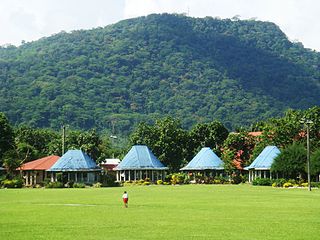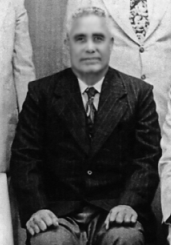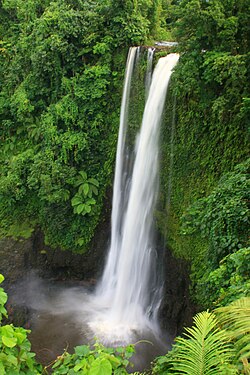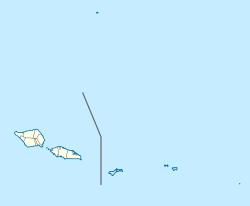
The Samoan Islands were first settled some 3,500 years ago as part of the Austronesian expansion. Both Samoa's early history and its more recent history are strongly connected to the histories of Tonga and Fiji, nearby islands with which Samoa has long had genealogical links as well as shared cultural traditions.

Politics of Samoa takes place in a framework of a parliamentary representative democratic state whereby the Prime Minister of Samoa is the head of government. Existing alongside the country's Western-styled political system is the fa'amatai chiefly system of socio-political governance and organisation, central to understanding Samoa's political system.

AfiogaFiamē Naomi Mataʻafa is a Samoan politician and High Chiefess (matai) who has served as the seventh Prime Minister of Samoa and leader of the Faʻatuatua i le Atua Samoa ua Tasi (FAST) party since 2021.
Le Mamea Matatumua Ata was one of the framers of the Constitution of Samoa. He held senior positions under the German colonial government of Samoa, New Zealand Trusteeship of Samoa and in the Independent State of Samoa.

Fiamē Mataʻafa Faumuina Mulinuʻu II was a Western Samoan paramount chief and politician. The holder of the Mataʻafa title, one of the four main Samoan chieftainships, he became the first prime minister of Western Samoa in 1959, serving until 1970. He held the position again from 1973 until his death in 1975.

Masiofo Laʻulu Fetauimalemau Mataʻafa, also known as Fetaui Mataʻafa, was a Samoan politician, chieftain and diplomat who served as a member of parliament for Lotofaga from 1975 to 1976, and again from 1979 to 1982. Mata'afa was later Samoa's first high commissioner to New Zealand. She was also the wife of Samoa's first Prime Minister, Fiame Mata'afa Faumuina Mulinu'u II. Their daughter, Fiamē Naomi Mataʻafa, is a matai high chieftess and former Cabinet Minister, former Deputy Prime Minister and current Prime Minister of Samoa. The honorific title "Masiofo" is the queenly title for the wife of a paramount chief in Samoa.

Samoa is made up of eleven itūmālō. These are the traditional eleven districts that were established well before European arrival. Each district has its own constitutional foundation (faavae) based on the traditional order of title precedence found in each district's faalupega.

Ātua is an ancient political district of Samoa, consisting of most of the eastern section of Upolu and the island Tutuila. Within Samoa's traditional polity, Ātua is ruled by the Tui Ātua together with the group of six senior orators of Lufilufi and 13 senior matai from throughout Ātua, comprising the Fale Ātua. The fono (meeting) of Atua's rulers takes place in Lufilufi on the great malae of Lalogafu'afu'a.
Matatumua Maimoana (1935–2012), also known as Matatumua Maimoaga Vermeulen, was a matai, politician, Nurse and Environmentalist of Samoa. Her chief title, Matatumua, was an orator's title from the village of Faleasiu. She was a former member of parliament in Samoa and the founder of the Samoa All People's Party (SAPP), becoming the first woman to lead a political party in the country. SAPP allowed people as young as 16, regardless of gender or whether they were matai to be officers in the organisation which included village branches. She was a founding member of the Human Rights Protection Party (HRPP), which has dominated Samoan politics in the last two decades.

The prime minister of the Independent State of Samoa is the head of government of Samoa. The prime minister is a member of the Legislative Assembly, and is appointed by the O le Ao o le Malo for a five-year term. Since independence in 1962, a total of seven individuals have served as prime minister. The incumbent was disputed due to the 2021 constitutional crisis, when Tuila'epa Sa'ilele Malielegaoi refused to accept the results of the 2021 general election. On 23 July 2021, the Samoan Court of Appeal ruled that the Faʻatuatua i le Atua Samoa ua Tasi (FAST) party had been in government since 24 May. Tuila'epa then conceded defeat, resulting in FAST party leader Fiamē Naomi Mataʻafa becoming prime minister.

Mata'afa Faumuina Fiame Mulinu'u I was a high chief of Samoa and a leader of the country's pro-independence Mau movement during the 1920's and 1930's. He was the holder of high-ranking ali'i chiefly titles: the Tama-a-'aiga Mata'afa, Fiame from Lotofaga and Faumuina from Lepea.

Matāʻafa is one of the four paramount tama-a-ʻaiga titles of Samoa. It is one of two such titles originating from the Atua district at the east end of Upolu island and has its historical seat in the village of Amaile. Prominent holders of the title include Matā'afa Iosefo of Falefa, one of the three rival candidates for the kingship of Samoa during the early colonial period, Matāʻafa Faumuina Fiame Mulinuʻu I of Lepea and Lotofaga, who became leader of Samoa's pro-independence Mau movement after Tupua Tamasese Lealofi III's assassination; and his son Fiame Matāʻafa Faumuina Mulinuʻu II (1921–1975), the first Prime Minister of Samoa.

Lepea is a village on the island of Upolu in Samoa. The picturesque settlement of round Samoan houses built in a concentric pattern in large open grounds (malae) is situated 5mins drive west of the capital Apia on the north central coast of the island. It is part of the Tuamasaga electoral district.

General elections were held in Western Samoa on 4 April 1964, the first since independence in 1962. All candidates ran as independents. Following the elections, Fiamē Mataʻafa Faumuina Mulinuʻu II remained Prime Minister.

General elections were held in Western Samoa on 7 February 1970. All candidates ran as independents, with voting restricted to matais and citizens of European origin, with the matais electing 45 MPs and Europeans two. Following the election, Tupua Tamasese Lealofi IV became Prime Minister.

General elections were held in Western Samoa on 24 February 1973. All candidates ran as independents and voting was restricted to matai and citizens of European origin, with the matai electing 45 MPs and Europeans two. Following the election, Fiame Mata'afa became Prime Minister for a second term, having previously held the office between 1959 and 1970.

Tui Ātua Tupua Tamasese Lealofi IV was the second prime minister of Samoa from 25 February 1970 to 20 March 1973 and again from 21 May 1975 to 24 March 1976. He held the title of Tupua Tamasese, one of the four main chiefly titles of Samoa from 1965 until his death in 1983.

Fonoti Matautia Ioane (John) Brown was a Western Samoan chief, businessman and politician. He was a member of the Legislative Assembly in two spells between 1948 and 1957, and held the portfolios of Agriculture and Health.

General elections were held in Samoa on 9 April 2021 to determine the composition of the 17th Parliament. The Human Rights Protection Party (HRPP), which had been in government for most of the time since 1982, was led into the election by Tuilaʻepa Saʻilele Malielegaoi, who had served as prime minister since 1998. The passage of the controversial Land and Titles bills by the HRPP led some party members to defect, establishing the Faʻatuatua i le Atua Samoa ua Tasi (FAST) party promising a repeal. FAST elected Fiamē Naomi Mataʻafa, the daughter of Samoa's first prime minister, as leader shortly before the election; she left the ruling party and resigned as deputy prime minister in 2020, also in opposition to the amendments.

A constitutional crisis began in Samoa on 22 May 2021 when O le Ao o le Malo Tuimalealiʻifano Vaʻaletoʻa Sualauvi II issued a proclamation purporting to prevent the Legislative Assembly from meeting in the wake of the general election in April 2021. Court rulings had upheld the election results, giving a parliamentary majority to the Faʻatuatua i le Atua Samoa ua Tasi (FAST) party, led by Fiamē Naomi Mataʻafa. On 24 May 2021, a makeshift ceremony was held outside of Parliament to swear in Mata'afa as prime minister. On 23 July the Court of Appeal declared that the ceremony was binding and that FAST had been the government since that date.
















